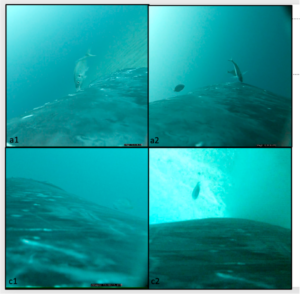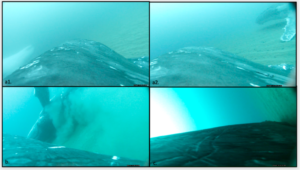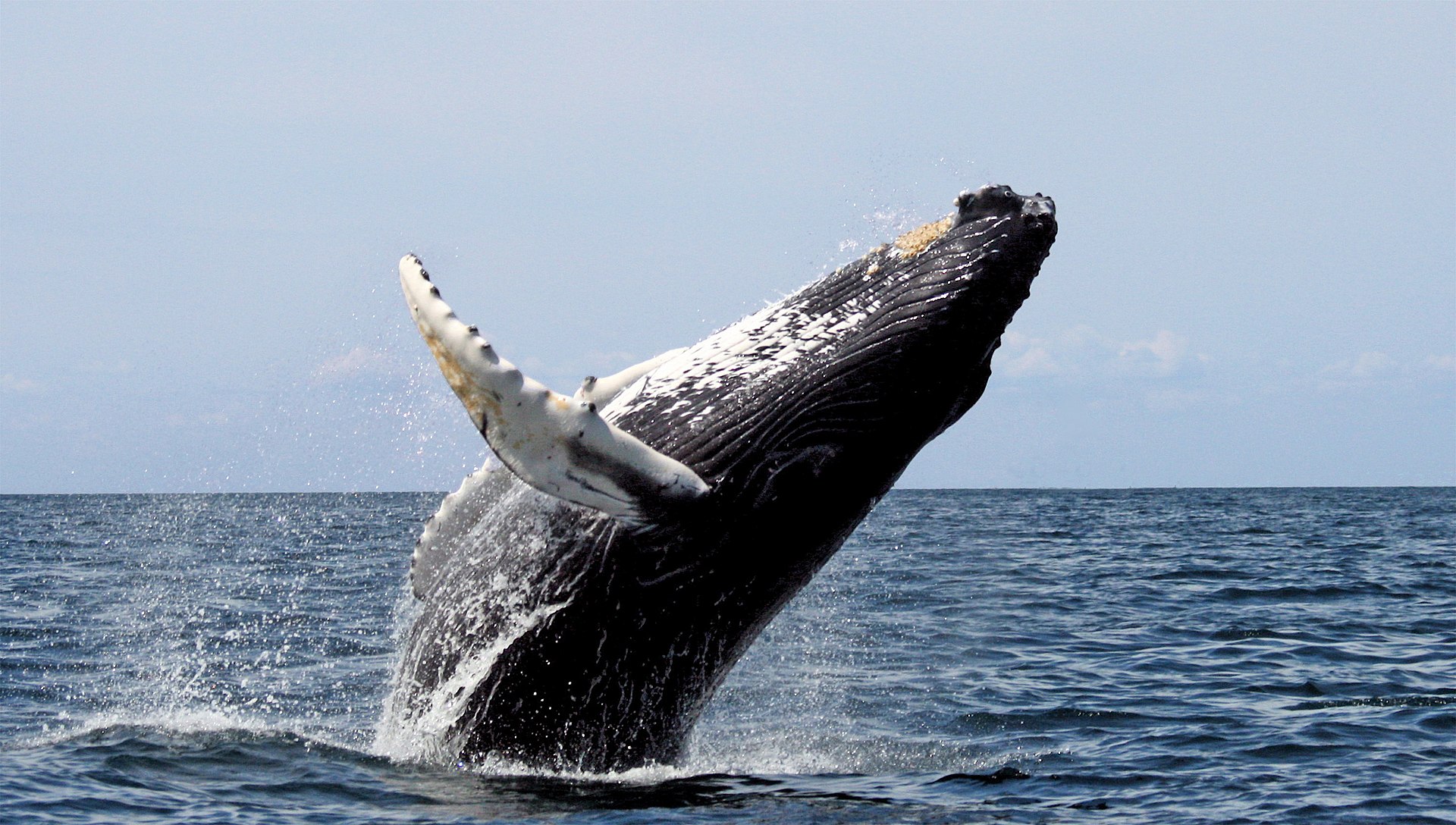Meynecke, J.-O., Gustafon, J., & Cade, D.E. (2023). Exfoliating Whales-Sandy Bottom Contact Behaviour of Humpback Whales. Journal of Marine Science and Engineering, 11, 600. https://doi.org/10.3390/jmse11030600
Humpback whales (Megaptera novaeangliae) have been spotted on many occasions off the coast of eastern Australia, at what seems to look like a spa day. Scientists at Gold Coast Griffith University in collaboration with Hopkins Marine Station and Stanford University in Monterey Bay have observed these whales performing a “rolling behaviour” along the sandy seafloor and believe this behaviour is the whales’ way of exfoliating.
Since whales are submerged all day, you might assume they do not need to take any skin care precautions, but quite the opposite! Humpback whales are covered with barnacles and whale lice, which are hard-shelled animals capable of infesting the entire body if left untreated. A surface behaviour known as a “breach”, in which whales leap out of the water and throw themselves onto the water’s surface, is one way of shedding these annoying critters. Researchers in this study believe to have witnessed humpbacks using a second behaviour to clean their skin rubbing their body against the sandy seafloor.
Gold Coast Bay, where this study was carried out, is a designated breeding and resting pit stop for humpbacks on their annual migration from their feeding grounds in Antarctica. Attending to their skin while resting in this shallow bay sounds perfectly credible, particularly after having travelled an average of ten thousand kilometres (six thousand miles), growth and parasites of the whales’ skin would slow them down and weaken their immune systems.
Other whales, such as the bowhead whale (Balaena mysticetus) are also known to scrub themselves against rocks to get rid of excess skin and are even thought to assess the geological and oceanographic properties of the bottom seafloor via this physical touch. Likewise, belugas (Delphinapterus leucas), rid themselves of dead skin by rubbing their body against limestone, pebble, and mud to encourage moulting. In terms of humpback whales, the footage of another study collected around Trindade Island, off the coast of Brazil shows Atlantic humpbacks carrying out a similar contact behaviour with the sediment.
This study captured three incidences (tags a, b, and c below) between August 2021 and September 2022 of humpbacks carrying out rolling behaviours. With this behaviour, the whales first, dive into the sand head-on, and then roll to either side (“side rolls”) or back, (“full rolls”) while stationary or moving. Footage was retrieved by deploying CATS (Customised Animal Tracking Solutions) tags that recorded information about what the whales were doing and where in the water column they were doing it. CATS tags each had four silicon suction cups attached close to the dorsal fin, and each had a release system to ensure that the devices came off after four hours for easy recollection.
The first incident showed a scarred male carrying out multiple rolls (five full rolls and two side rolls). An accompanying whale was also seen doing a full roll. Additionally multiple silver trevallies (Pseudocaranx georgianus) were seen feeding on the dead, excess whale skin.

The second video showed a male in a pod of six humpback whales. While these whales also performed rolling activities, they were also seen engaging in aggressive and competitive behaviours, having a mother and her calf amongst them. Males often harass mother-calf pairs for possible mating. Some common dolphins, (Delphinus delphis) were seen joining the group as well. Dolphin and whale pods are known to occasionally interact with each other.
The third and last video shows two very active adults, who engaged in a lot of surface activities, along with what seems to be a courtship behaviour in addition to typical rolling behaviours. A total of two full rolls and three side rolls were documented.

But can we truly be certain, that humpbacks are “grooming” themselves, or does this rolling behaviour have a different motive? Some studies believe that rolling could be linked to feeding and socialising, rather than cleaning! Orcas in British Columbia scrub their body against rocks, but more for reasons of social bonding, rather than as a skin treatment.
Before drawing to any conclusions, we should keep in mind that the whales may have been irritated by the tags, and mimicked exfoliating behaviours to brush them off. However, scientists do not think this is the case, as these whales did not rub themselves anywhere near their tags!
Nevertheless, Dr Olaf Meynecke and his colleagues would like to take this study to the next level and address possible links between rolling behaviours and social bonding or calming activity in future surveys. Using larger field of view cameras could also assist in learning more about humpbacks and their behaviour, especially because these would capture surrounding individuals’ responses to behaviours. In addition, observing humpbacks in other areas with shallow, sandy seafloors, such as Hervey Bay, located three hundred kilometres (two hundred miles) north of Gold Coast would allow scientists to understand whether rolling is truly correlated with exfoliating.
Despite not being certain why “Aussie” humpbacks are displaying this rolling behaviour, we should at least strive to make sandy habitats available to them by creating local marine sanctuaries.
You never know-by giving whales more safe places to swim, they might grant us a glimpse of a behaviour we have not yet seen!
Cover image: Humpback whale (Megaptera novaeangliae) breaching (Wikipedia: Whit Welles, 2007)
I have a master’s degree in marine biology, ecology, and behavioural biology obtained from the University of Vienna. Since I can remember I wanted to become a marine biologist, despite growing up in a country without an ocean, but I guess my South African roots just kept on pushing to make this dream come true. After graduation I spent a year in Australia and assisted several NGOs with marine educational talks and citizen science programmes. Here I had the privilege of observing humpback whales on their annual migration passed the eastern coast of Australia, and participating in seagrass and rockpool monitoring activities. With a heavy heart I left Australia, but soon after obtained a position as a marine educator at Malta National Aquarium. Today I am based in Germany exploring marine critters in the North and Baltic Sea and if I am not too busy, you’ll find me diving in the Red Sea, blogging on my Facebook page, swimming, running, reading, and meditating.

